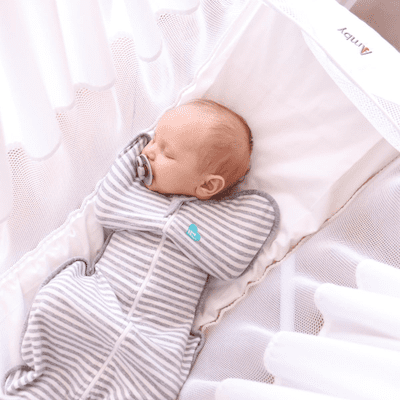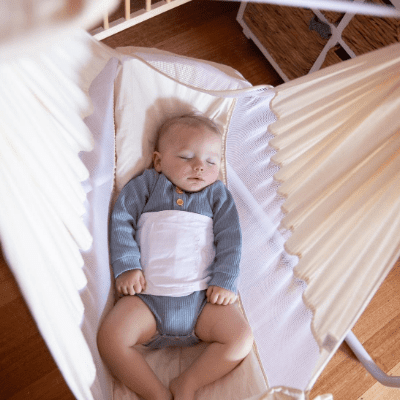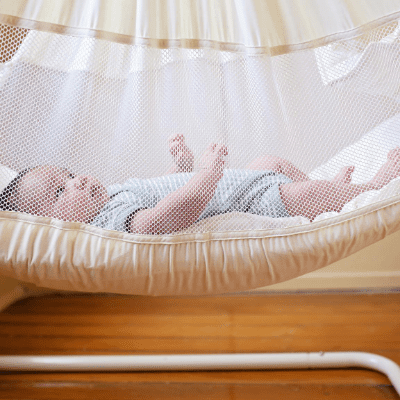Product Use
When should babies start using the hammock and how long should they sleep in it?
Babies can generally sleep in the Amby baby hammock from birth to about 12 months. Many babies sleep in it for much longer.
Ideally it’s best to use the hammock from birth. In fact many mothers in Australia take the hammock into hospital with them. However, there are also thousands of babies who start using the hammock anywhere from a few weeks to seven or eight months old. It appears that even at that age babies take to it quite easily.
The Amby spring can safely hold up to 12kg / 26lbs of weight (approximately 12 months of age). For heavier babies and toddlers, a Heavy Duty Spring can be purchased separately and can hold up to 20kg / 44lbs of weight. The Amby frame itself has been rated to hold up to 45kg / 99lbs of weight.
How can I wash my baby hammock?
The hammock sling, mattress cover and sheets can be washed on a gentle machine cycle or by handwashing using cold water only.
The foam mattress can be hand washed in cold water.
Drip dry or line dry only, do not use a dryer.
Why does my baby wriggle around in the baby hammock?
It has to be noted that babies sleeping in the hammock tend to wriggle and move around more than if they were sleeping in a cot/crib. This must not be misconstrued as ‘baby wanting more room’. This movement is in fact triggered by the tactile touch that the baby experiences in the hammock. As in gestation, moving and wriggling is all part and parcel of muscle toning and physical development. Many mothers have reported that their hammock babies appeared to grow faster than their previous babies who slept in cots. This is quite understandable, as a baby who sleeps better and is happy and contented will more than likely feed better and therefore grow faster.
Do babies sleep in it at night as well?
Yes, definitely. It is a ‘full time’ baby bed. Many families take it on holidays, to grandmothers and even to baby sitters. This gives your baby the advantage of sleeping in his own special bed wherever he may be.
Should babies always sleep on their backs in the hammock?
Yes, the configuration of the hammock makes it virtually impossible for a baby to sleep prone (on his tummy). The desired and recommended position is the supine (on the back) position. The SIDS and Kids organisation recommends that babies sleep on their back from birth, not on their tummy or side. More information can be found at www.sidsandkids.org/safe-sleeping
Are there any specific ‘transitioning’ techniques?
The hammock is an early development product for newborns up to around 12 months. As far as transitioning goes, it really depends on the baby’s personality; some develop their ‘independence’ faster than others. We suggest that you look for ‘signs’- restlessness in the hammock even though they have slept in it for months, refusing to go into it etc.
As in most things, there is no magic formula. Let your baby tell you when it’s time. Some babies will transit to another bed more easily than others. However, even with difficult transitions, bear in mind that the hammock allows your baby to thrive for many months, making life much easier all round.
Can my baby roll over in the hammock?
Not necessarily as the suspended nature of the hammock makes it very difficult to roll over. The mattress actually holds babies safely on their back.
When babies are older and strong enough (around 4-6 months) there is a small chance they will be able to roll over on their side or tummy, with effort. In some Asian countries babies sleep in hammocks without the mattress. This makes it considerably harder to roll over. If you have a persistant “roller” in the hammock, we recommend that baby sleep in the hammock without the mattress or you can use a Safe T Sleep Wrap to safely keep your baby on his/her back.
The Amby design is not made for tummy sleeping
Do not under any circumstance sleep your baby in the hammock on his or her tummy.
Keep in mind that most normal healthy babies tend to try and roll and turn (experiment) in any bed. If this occurs, monitor your baby and if you feel that it is time to transit, then do so gradually to make the transition easier. Alternatively, if you still wish to continue using your hammock, you can purchase a Safe T Sleep Wrap from our website to hold keep your baby held safely on their back.
I have heard from friends who have used the Amby Hammock that it is good for colic and reflux. How does the hammock help relieve the symptoms of these conditions?
Colic is usually a recurring condition that affects some 25% of young babies. The actual cause of colic is yet unknown, but amongst the factors that have been implicated are intestinal gas pains (small bubbles of air/gas trapped inside a baby’s under developed intestines) and nervous tension.
When a baby is bounced gently to sleep in the Amby, it may have the effect of ‘pushing’ the intestinal gas along and releasing the trapped bubbles of air, which helps make the baby more comfortable.
The rhythm of the spring action also has the incredible ability to soothe a baby, easing nervous tension, relaxing the muscles (an attack of colic is usually accompanied by intense crying with legs pulled up, abdomen becoming rigid and fists being clenched) and ‘limping’ the whole body, rendering the baby a degree of comfort that is otherwise lacking.
Gastroesophageal reflux is often caused by an incoordination of the baby’s upper intestinal tract. They tend to spit up or throw up frequently after a feed and if a baby cries all the time, they fill their tummies with air, grunt and strain. This can make the reflux worse.
Fortunately, in most cases, babies grow out of it. Reflux usually starts to get better when a baby can sit up quite well without assistance at around 6 months of age. Time, it appears, is the only ‘cure’ in most cases.
There are, however treatments that can help relieve the symptoms of chronic reflux. Apart from medication, one of the more effective treatments is positioning. Theoretically, the best sleeping position is where the baby’s upper body is slightly elevated.
The Amby Hammock’s ability to relax and pacify a baby helps. The ‘head’ end of the hammock can also be easily elevated to an angle that is best for a baby with reflux. Many paediatricians do send babies with severe reflux to us for the Amby baby hammock.
How does the hammock affect the spinal development of a baby?
Posture – if you observe your baby in the hammock, you will see that the so called ‘curve’ on her back is practically non existent once she lies in the hammock, even though the hammock does look curved when there is no baby in it. The ‘curve’ in fact flattens out once a baby is placed in the hammock.
Many doctors, paediatricians and chiropractors actually buy and use the hammock for their own babies. The question of spinal development and posture has never been of concern to them. Indeed some even believe that the suppleness of the hammock and its accompanying suspension/floatation effect may even be beneficial to spinal development.
Babies will come to no harm when they sleep in the hammock. They should develop (as most hammock babies do) into happy healthy and extremely contented babies. Care givers will have the luxury of the sleep that many have been deprived of because of an unhappy, restless and sleepless baby.
Why is a hammock better than letting a child cry it out in a cot?
As far as we are concerned, ‘crying it out’ is the least preferred option. A baby’s cry is a signal of distress, which is a result of either a physical or a mental discomfort. When placed in an unsuitable bed coupled with isolation a baby’s feelings of comfort and security are jeopardised. They feel abandoned and their confidence in a ‘secure and comfortable’ environment is shattered. They can develop into ‘difficult’ babies.
How easily will my child move to a bed after being in a hammock?
There are mothers in Australia who use the hammock in isolation in the baby’s own room and there are others who have the baby with them in their room. Either way it seems that the transition to baby’s own bed or room does not appear to be a major problem.
Most babies who use the hammock as their bed develop into happy, healthy and contented babies. They are less inclined to be insecure and they do not seem to cry a lot. They are used to long, sound and unbroken sleep – untroubled either by insecurity or discomfort. These are traits that appear to be common amongst ‘hammock babies’. They tend to be ‘easy’ babies and as is the case with most ‘easy’ babies, they are confident and do not get ruffled easily. So the transition to a bed is ‘no big deal’ to them. They appear to cope with it quite easily.
We get asked this question quite often by parents who bought the hammock for their babies. So far, with tens of thousands of hammocks used in Australia, we have not had a single report from a parent complaining about the difficulty of getting their child to switch over to a bed when it was time to do so
The above replies are for educational purposes only. It should not be viewed as a substitute for medical advice.



